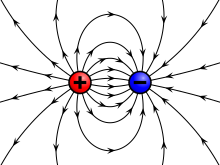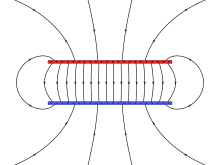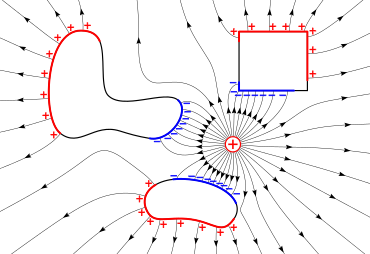Electric field
| Electric field | |
|---|---|
 Effects of an electric field. The girl is touching an electrostatic generator, which charges her body with a high voltage. Her hair, which is charged with the same polarity, is repelled by the electric field of her head and stands out from her head. | |
Common symbols | E |
| SI unit | volts per meter (V/m) |
| In SI base units | m⋅kg⋅s−3⋅A−1 |
Behaviour under coord transformation | vector |
Derivations from other quantities | F / q |
| Articles about |
| Electromagnetism |
|---|
 |
An electric field (sometimes E-field[1]) is the physical field that surrounds each electric charge and exerts force on all other charges in the field, either attracting or repelling them.[2][3] Electric fields originate from electric charges, or from time-varying magnetic fields. Electric fields and magnetic fields are both manifestations of the electromagnetic force, one of the four fundamental forces (or interactions) of nature.
Electric fields are important in many areas of physics, and are exploited practically in electrical technology. In atomic physics and chemistry, for instance, the electric field is the attractive force holding the atomic nucleus and electrons together in atoms. It is also the force responsible for chemical bonding between atoms that result in molecules.
Other applications of electric fields include motion detection via electric field proximity sensing and an increasing number of diagnostic and therapeutic medical uses.
The electric field is defined mathematically as a vector field that associates to each point in space the (electrostatic or Coulomb) force per unit of charge exerted on an infinitesimal positive test charge at rest at that point.[4][5][6] The derived SI units for the electric field are volts per meter (V/m), exactly equivalent to newtons per coulomb (N/C).[7]
Description

The electric field is defined at each point in space as the force (per unit charge) that would be experienced by a vanishingly small positive test charge if held at that point.[8]: 469–70 As the electric field is defined in terms of force, and force is a vector (i.e. having both magnitude and direction), it follows that an electric field is a vector field.[8]: 469–70 Vector fields of this form are sometimes referred to as force fields. The electric field acts between two charges similarly to the way the gravitational field acts between two masses, as they both obey an inverse-square law with distance.[9] This is the basis for Coulomb's law, which states that, for stationary charges, the electric field varies with the source charge and varies inversely with the square of the distance from the source. This means that if the source charge were doubled, the electric field would double, and if you move twice as far away from the source, the field at that point would be only one-quarter its original strength.
The electric field can be visualized with a set of lines whose direction at each point is the same as the field's, a concept introduced by Michael Faraday,[10] whose term 'lines of force' is still sometimes used. This illustration has the useful property that the field's strength is proportional to the density of the lines.[11] The field lines are the paths that a point positive charge would follow as it is forced to move within the field, similar to trajectories that masses follow within a gravitational field. Field lines due to stationary charges have several important properties, including always originating from positive charges and terminating at negative charges, they enter all good conductors at right angles, and they never cross or close in on themselves.[8]: 479 The field lines are a representative concept; the field actually permeates all the intervening space between the lines. More or fewer lines may be drawn depending on the precision to which it is desired to represent the field.[10] The study of electric fields created by stationary charges is called electrostatics.
Faraday's law describes the relationship between a time-varying magnetic field and the electric field. One way of stating Faraday's law is that the curl of the electric field is equal to the negative time derivative of the magnetic field.[12]: 327 In the absence of time-varying magnetic field, the electric field is therefore called conservative (i.e. curl-free).[12]: 24, 90–91 This implies there are two kinds of electric fields: electrostatic fields and fields arising from time-varying magnetic fields.[12]: 305–307 While the curl-free nature of the static electric field allows for a simpler treatment using electrostatics, time-varying magnetic fields are generally treated as a component of a unified electromagnetic field. The study of time varying magnetic and electric fields is called electrodynamics.
Mathematical formulation
Electric fields are caused by electric charges, described by Gauss's law,[13] and time varying magnetic fields, described by Faraday's law of induction.[14] Together, these laws are enough to define the behavior of the electric field. However, since the magnetic field is described as a function of electric field, the equations of both fields are coupled and together form Maxwell's equations that describe both fields as a function of charges and currents.
Electrostatics
In the special case of a steady state (stationary charges and currents), the Maxwell-Faraday inductive effect disappears. The resulting two equations (Gauss's law and Faraday's law with no induction term ), taken together, are equivalent to Coulomb's law, which states that a particle with electric charge at position exerts a force on a particle with charge at position of:[15]
- where is the unit vector in the direction from point to point , and ε0 is the electric constant (also known as "the absolute permittivity of free space") with units C2 m−2 N−1
Note that , the vacuum electric permittivity, must be substituted with , permittivity, when charges are in non-empty media. When the charges and have the same sign this force is positive, directed away from the other charge, indicating the particles repel each other. When the charges have unlike signs the force is negative, indicating the particles attract. To make it easy to calculate the Coulomb force on any charge at position this expression can be divided by leaving an expression that only depends on the other charge (the source charge)[16][6]
This is the electric field at point due to the point charge ; it is a vector-valued function equal to the Coulomb force per unit charge that a positive point charge would experience at the position . Since this formula gives the electric field magnitude and direction at any point in space (except at the location of the charge itself, , where it becomes infinite) it defines a vector field. From the above formula it can be seen that the electric field due to a point charge is everywhere directed away from the charge if it is positive, and toward the charge if it is negative, and its magnitude decreases with the inverse square of the distance from the charge.
The Coulomb force on a charge of magnitude at any point in space is equal to the product of the charge and the electric field at that point
The units of the electric field in the SI system are newtons per coulomb (N/C), or volts per meter (V/m); in terms of the SI base units they are kg⋅m⋅s−3⋅A−1
Superposition principle
Due to the linearity of Maxwell's equations, electric fields satisfy the superposition principle, which states that the total electric field, at a point, due to a collection of charges is equal to the vector sum of the electric fields at that point due to the individual charges.[6] This principle is useful in calculating the field created by multiple point charges. If charges are stationary in space at points , in the absence of currents, the superposition principle says that the resulting field is the sum of fields generated by each particle as described by Coulomb's law:
- where is the unit vector in the direction from point to point .
Continuous Charge Distributions
The superposition principle allows for the calculation of the electric field due to a continuous distribution of charge (where is the charge density in coulombs per cubic meter). By considering the charge in each small volume of space at point as a point charge, the resulting electric field, , at point can be calculated as
where is the unit vector pointing from to . The total field is then found by "adding up" the contributions from all the increments of volume by integrating over the volume of the charge distribution :
Similar equations follow for a surface charge with continuous charge distribution where is the charge density in coulombs per square meter
and for line charges with continuous charge distribution where is the charge density in coulombs per meter.
Electric potential
If a system is static, such that magnetic fields are not time-varying, then by Faraday's law, the electric field is curl-free. In this case, one can define an electric potential, that is, a function such that .[17] This is analogous to the gravitational potential. The difference between the electric potential at two points in space is called the potential difference (or voltage) between the two points.
In general, however, the electric field cannot be described independently of the magnetic field. Given the magnetic vector potential, A, defined so that , one can still define an electric potential such that:
Where is the gradient of the electric potential and is the partial derivative of A with respect to time.
Faraday's law of induction can be recovered by taking the curl of that equation [18]
which justifies, a posteriori, the previous form for E.
Continuous vs. discrete charge representation
The equations of electromagnetism are best described in a continuous description. However, charges are sometimes best described as discrete points; for example, some models may describe electrons as point sources where charge density is infinite on an infinitesimal section of space.
A charge located at can be described mathematically as a charge density , where the Dirac delta function (in three dimensions) is used. Conversely, a charge distribution can be approximated by many small point charges.
Electrostatic fields

Electrostatic fields are electric fields which do not change with time, which happens when charges and currents are stationary. In that case, Coulomb's law fully describes the field.[19]
Parallels between electrostatic and gravitational fields
Coulomb's law, which describes the interaction of electric charges:
is similar to Newton's law of universal gravitation:
(where ).
This suggests similarities between the electric field E and the gravitational field g, or their associated potentials. Mass is sometimes called "gravitational charge".[20]
Electrostatic and gravitational forces both are central, conservative and obey an inverse-square law.
Uniform fields

A uniform field is one in which the electric field is constant at every point. It can be approximated by placing two conducting plates parallel to each other and maintaining a voltage (potential difference) between them; it is only an approximation because of boundary effects (near the edge of the planes, electric field is distorted because the plane does not continue). Assuming infinite planes, the magnitude of the electric field E is:
where ΔV is the potential difference between the plates and d is the distance separating the plates. The negative sign arises as positive charges repel, so a positive charge will experience a force away from the positively charged plate, in the opposite direction to that in which the voltage increases. In micro- and nano-applications, for instance in relation to semiconductors, a typical magnitude of an electric field is in the order of 106 V⋅m−1, achieved by applying a voltage of the order of 1 volt between conductors spaced 1 µm apart.
Electrodynamic fields

Electrodynamic fields are electric fields which do change with time, for instance when charges are in motion. In this case, a magnetic field is produced in accordance with Ampère's circuital law (with Maxwell's addition), which, along with Maxwell's other equations, defines the magnetic field, , in terms of its curl:
where is the current density, is the vacuum permeability, and is the vacuum permittivity.
That is, both electric currents (i.e. charges in uniform motion) and the (partial) time derivative of the electric field directly contributes to the magnetic field. In addition, the Maxwell–Faraday equation states
These represent two of Maxwell's four equations and they intricately link the electric and magnetic fields together, resulting in the electromagnetic field. The equations represent a set of four coupled multi-dimensional partial differential equations which, when solved for a system, describe the combined behavior of the electromagnetic fields. In general, the force experienced by a test charge in an electromagnetic field is given by the Lorentz force law:
Energy in the electric field
The total energy per unit volume stored by the electromagnetic field is[21]
where ε is the permittivity of the medium in which the field exists, its magnetic permeability, and E and B are the electric and magnetic field vectors.
As E and B fields are coupled, it would be misleading to split this expression into "electric" and "magnetic" contributions. However, in the steady-state case, the fields are no longer coupled (see Maxwell's equations). It makes sense in that case to compute the electrostatic energy per unit volume:
The total energy U stored in the electric field in a given volume V is therefore
The electric displacement field
Definitive equation of vector fields
In the presence of matter, it is helpful to extend the notion of the electric field into three vector fields:[22]
where P is the electric polarization – the volume density of electric dipole moments, and D is the electric displacement field. Since E and P are defined separately, this equation can be used to define D. The physical interpretation of D is not as clear as E (effectively the field applied to the material) or P (induced field due to the dipoles in the material), but still serves as a convenient mathematical simplification, since Maxwell's equations can be simplified in terms of free charges and currents.
Constitutive relation
The E and D fields are related by the permittivity of the material, ε.[23][22]
For linear, homogeneous, isotropic materials E and D are proportional and constant throughout the region, there is no position dependence:
For inhomogeneous materials, there is a position dependence throughout the material:[24]
For anisotropic materials the E and D fields are not parallel, and so E and D are related by the permittivity tensor (a 2nd order tensor field), in component form:
For non-linear media, E and D are not proportional. Materials can have varying extents of linearity, homogeneity and isotropy.
See also
- Classical electromagnetism
- Electricity
- History of electromagnetic theory
- Optical field
- Magnetism
- Teltron tube
- Teledeltos, a conductive paper that may be used as a simple analog computer for modelling fields
References
- ^ Roche, John (2016). "Introducing electric fields". Physics Education. 51 (5): 055005. Bibcode:2016PhyEd..51e5005R. doi:10.1088/0031-9120/51/5/055005.
- ^ Purcell, Edward M.; Morin, David J. (2013). Electricity and Magnetism (3rd ed.). New York: Cambridge University Press. pp. 14–20. ISBN 978-1-107-01402-2.
- ^ Browne, p 225: "... around every charge there is an aura that fills all space. This aura is the electric field due to the charge. The electric field is a vector field... and has a magnitude and direction."
- ^ Richard Feynman (1970). The Feynman Lectures on Physics Vol II. Addison Wesley Longman. pp. 1–3, 1–4. ISBN 978-0-201-02115-8.
- ^ Purcell, Edward M.; Morin, David J. (2013). Electricity and Magnetism (3rd ed.). New York: Cambridge University Press. pp. 15–16. ISBN 978-1-107-01402-2.
- ^ a b c Serway, Raymond A.; Vuille, Chris (2014). College Physics, 10th Ed. Cengage Learning. pp. 532–533. ISBN 978-1305142824.
- ^ The International System of Units (PDF) (9th ed.), International Bureau of Weights and Measures, Dec 2022, ISBN 978-92-822-2272-0, p. 23
- ^ a b c Sears, Francis; et al. (1982), University Physics, Sixth Edition, Addison Wesley, ISBN 0-201-07199-1
- ^ Umashankar, Korada (1989), Introduction to Engineering Electromagnetic Fields, World Scientific, pp. 77–79, ISBN 9971-5-0921-0
- ^ a b Morely & Hughes, Principles of Electricity, Fifth edition, p. 73, ISBN 0-582-42629-4
- ^ Tou, Stephen (2011). Visualization of Fields and Applications in Engineering. John Wiley and Sons. p. 64. ISBN 9780470978467.
- ^ a b c Griffiths, David J. (David Jeffery), 1942- (1999). Introduction to electrodynamics (3rd ed.). Upper Saddle River, N.J.: Prentice Hall. ISBN 0-13-805326-X. OCLC 40251748.
{{cite book}}: CS1 maint: multiple names: authors list (link) CS1 maint: numeric names: authors list (link) - ^ Purcell, p 25: "Gauss's Law: the flux of the electric field E through any closed surface... equals 1/e times the total charge enclosed by the surface."
- ^ Purcell, p 356: "Faraday's Law of Induction."
- ^ Purcell, p7: "... the interaction between electric charges at rest is described by Coulomb's Law: two stationary electric charges repel or attract each other with a force proportional to the product of the magnitude of the charges and inversely proportional to the square of the distance between them.
- ^ Purcell, Edward (2011). Electricity and Magnetism, 2nd Ed. Cambridge University Press. pp. 8–9. ISBN 978-1139503556.
- ^ gwrowe (8 October 2011). "Curl & Potential in Electrostatics" (PDF). physicspages.com. Archived from the original (PDF) on 22 March 2019. Retrieved 2 November 2020.
- ^ Huray, Paul G. (2009). Maxwell's Equations. Wiley-IEEE. p. 205. ISBN 978-0-470-54276-7.
- ^ Purcell, pp. 5-7.
- ^ Salam, Abdus (16 December 1976). "Quarks and leptons come out to play". New Scientist. 72: 652.
- ^ Introduction to Electrodynamics (3rd Edition), D.J. Griffiths, Pearson Education, Dorling Kindersley, 2007, ISBN 81-7758-293-3
- ^ a b Electromagnetism (2nd Edition), I.S. Grant, W.R. Phillips, Manchester Physics, John Wiley & Sons, 2008, ISBN 978-0-471-92712-9
- ^ Electricity and Modern Physics (2nd Edition), G.A.G. Bennet, Edward Arnold (UK), 1974, ISBN 0-7131-2459-8
- ^ Landau, Lev Davidovich; Lifshitz, Evgeny M. (1963). "68 the propagation of waves in an inhomogeneous medium". Electrodynamics of Continuous Media. Course of Theoretical Physics. Vol. 8. Pergamon. p. 285. ISBN 978-0-7581-6499-5.
In Maxwell's equations… ε is a function of the co-ordinates.
- Purcell, Edward; Morin, David (2013). ELECTRICITY AND MAGNETISM (3rd ed.). Cambridge University Press, New York. ISBN 978-1-107-01402-2.
- Browne, Michael (2011). PHYSICS FOR ENGINEERING AND SCIENCE (2nd ed.). McGraw-Hill, Schaum, New York. ISBN 978-0-07-161399-6.
External links
- Electric field in "Electricity and Magnetism", R Nave – Hyperphysics, Georgia State University
- Frank Wolfs's lectures at University of Rochester, chapters 23 and 24
- Fields – a chapter from an online textbook































































